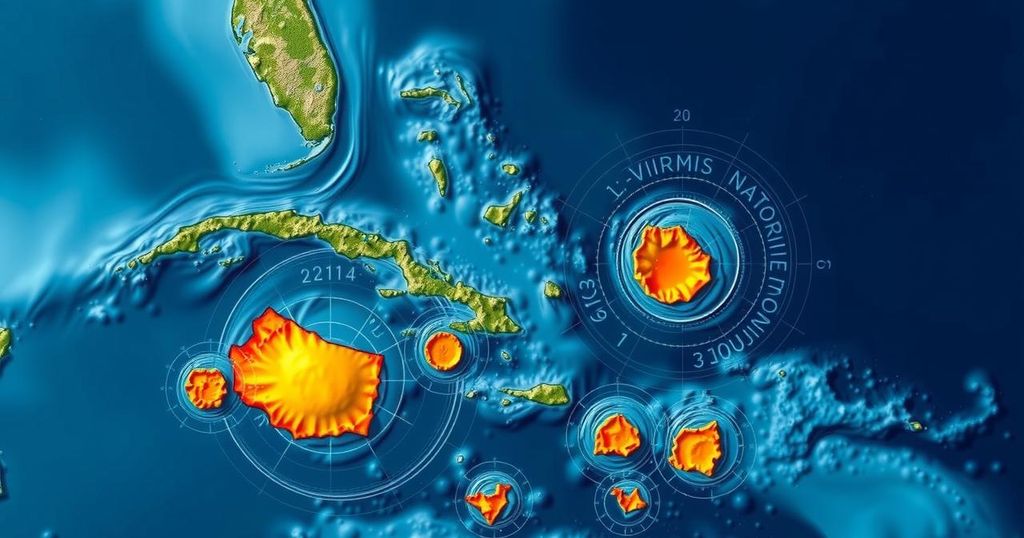Understanding Earthquake Preparedness in the Virgin Islands

As hurricane season ends, the focus shifts to earthquakes in the Virgin Islands, where seismic activity is prevalent year-round. A recent 6.8 quake near Cuba serves as a reminder of the importance of earthquake safety. The Puerto Rico Seismic Network (PRSN) monitors seismic events, providing timely information and education to the public on preparedness measures against earthquakes and tsunamis.
As hurricane season concludes, it is essential to focus on another significant natural hazard in the Caribbean: earthquakes. The Virgin Islands frequently experience seismic activity, exemplified by a recent 6.8 magnitude quake near Cuba, which serves as a reminder of the importance of earthquake preparedness among residents and visitors. This article examines insights from Elizabeth Vanacore, a seismologist at the Puerto Rico Seismic Network (PRSN), emphasizing safety measures and the nature of earthquakes in the region. The PRSN, integral to monitoring seismic activity in Puerto Rico and the Virgin Islands, operates under the auspices of the University of Puerto Rico Mayagüez Department of Geology. Vanacore explains that PRSN is tasked with disseminating vital information about earthquakes and collaborating with emergency management agencies to keep the public informed about seismic risks. The network’s data collection includes over 200 real-time seismic stations and accelerometer readings, ensuring timely updates after seismic events. The recent strong earthquake in Cuba is associated with the Septentrional-Oriente Fault Zone and serves as a reminder of the unpredictable nature of earthquakes. Despite this event, Vanacore reassures the public that it does not imply an imminent earthquake threat to the Virgin Islands, as geological behaviors vary by region. She clarifies that earthquake magnitudes indicate energy release levels, directly correlating changes in magnitude to significant variations in destructive potential. Vanacore emphasizes the unpredictable occurrence of earthquakes and their devastating potential for the Virgin Islands, referencing past hazards such as the 1867 Anegada Passage earthquake and tsunami. In light of this, she advocates for preparedness, noting that individuals should adopt safety measures such as “Drop, Cover, and Hold On” during seismic events. The PRSN provides educational resources for preparedness alongside social engagements to enhance community resilience against potential seismic events. Finally, understanding the complex tectonic setting of the Caribbean is crucial to developing effective emergency management strategies. Collaboration among local scientists and emergency agencies is vital for improving public preparedness and resilience against earthquakes and tsunamis. In conclusion, proper preparedness and continuous education about earthquake safety remain imperative for residents and visitors to the Virgin Islands. Engaging in safety drills, accessing educational resources from the PRSN and Virgin Islands Territorial Emergency Management Agency, and actively participating in community efforts are essential measures toward ensuring safety in the event of seismic activity.
The Virgin Islands and Caribbean regions are prone to year-round seismic activity, making earthquake preparedness a critical issue for local residents and visitors. The Puerto Rico Seismic Network (PRSN) is pivotal in monitoring seismic events and disseminating timely information to ensure public safety. Recent earthquakes, particularly one near Cuba, underscore the necessity of understanding earthquakes’ mechanics and potential hazards in this region. This background sets the context for the essential role of the PRSN in enhancing earthquake awareness and safety through education and data sharing.
In summary, the Virgin Islands must prioritize earthquake preparedness due to their geographical vulnerability to seismic events. The PRSN’s ongoing efforts to gather real-time data and inform the public about potential hazards are invaluable. By engaging in preparedness training and utilizing local resources, residents and visitors can enhance their ability to cope with unexpected earthquakes, thereby minimizing risks to personal safety and community resilience.
Original Source: stcroixsource.com








